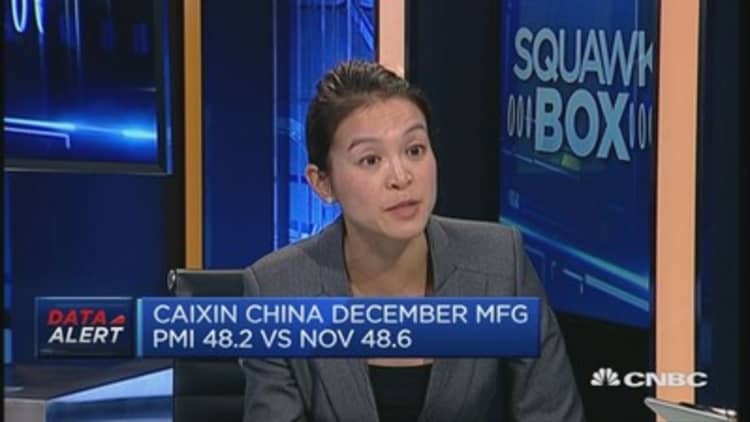
The Caixin Purchasing Managers' Index (PMI) came in weaker than expected, spurring fresh fears over China's economic growth and sending markets around the region lower.
The manufacturing PMI fell to 48.2 in December, from 48.6 in November, contracting for a tenth month and coming in below a Reuters poll forecast for 49.0. Levels below 50 indicate contraction. The Caixin PMI is a closely-watched gauge of nationwide manufacturing activity, which focuses on smaller and medium-sized companies, filling a niche that isn't covered by the official data.
"Data suggested that client demand was weak both at home and abroad, with new export business falling for the first time in three months in December," Markit, which compiles the survey, said in a release. "As a result, manufacturers continued to trim their staff numbers and reduce their purchasing activity in line with lower production requirements."
Markets around the region certainly weren't cheering. The Shanghai Composite was down as much as 4.1 percent after the data's release, while Australian shares erased early gains, with the S&P/ASX 200 index off as much as 0.4 percent. The Australian dollar dropped from around 72.86 U.S. cents before the reading on one of its largest trading partners to as low as 72.05 U.S. cents.
The sharp drop in the Caixin PMI contrasted with a small tick up in the official PMI data released over the weekend, which showed the index was at 49.7 in December, in line with forecasts from a Reuters poll and up a tad from November's 49.6.
The official non-manufacturing PMI, which tracks the services sector, rose to 54.4 in December from 53.6 in November.
"We're seeing sluggish stabilization of sorts. We're not seeing a sharp drop off, but there's not enough cause for cheer," Donna Kwok, senior China economist at UBS, told CNBC.
Tepid activity reflected by the surveys has also hurt the financial performance of companies in the mainland: Chinese industrial companies' profits fell 1.4 percent on year in November, according to data released in December, marking a sixth straight month of declines.
Analysts have raised a slew of concerns about the Chinese economy as it transitions from a manufacturing base to services: The country is hooked on debt, the shadow banking sector has imploded, the property market sometimes shows signs of a bubble and major industries are slowing.
Chinese economic growth fell to 6.9 percent in the third quarter, dropping below the 7 percent mark for the first time since the global financial crisis of 2008-2009.
China's growth rate is expected to be 6.8 percent in 2015, according to the International Monetary Fund's latest "World Economic Outlook" report published in October.
Although robust, that growth rate has been slowing down year-on-year. In 2013, China's economy grew 7.7 percent, but in 2014 China's GDP expanded by 7.3 percent. The IMF predicted further slowing growth in 2016, to 6.3 percent.
To counter slowing growth, policy makers have taken a slew of easing measures, including a slew of interest rate and reserve requirement ratio cuts from the central bank, the People's Bank of China.
Analysts are predicting further easing measures ahead to bolster the mainland's slipping growth rate.
"What we need to see in 2016 is further easing, more aggressive easing on both monetary and fiscal policy to really provide a substantial boost to lift the economy away from this low growth or contractionary, deflationary state that we're in," John Zhu, a greater China economist at HSBC, told CNBC.
But he expects the official 2015 GDP growth target of "around 7 percent" is probably achievable because of a boost in the first half of last year from the financial services industry, but he expects 2016 will be "more interesting" as that effect fades.
-Holly Ellyat contributed to this article.
—By CNBC.Com's Leslie Shaffer; Follow her on Twitter @LeslieShaffer1




